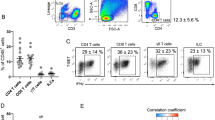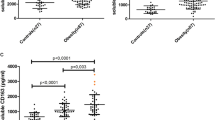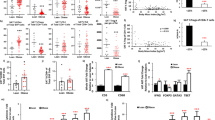Abstract
Background/Objectives:
In lipodystrophy (LD) adipose tissue function to store lipids is impaired, leading to metabolic syndrome, similar to that found in obesity. Emerging evidence links dysmetabolism with disorders of the immune system. Our aim is to investigate whether T-cell populations with regulatory function and monocyte-derived macrophages (MDMs) are affected by LD and obesity.
Subjects/Methods:
Blood was collected from 16 LD, 16 obese (OB, BMI>30 kg m−2) and 16 healthy normal-weight women (CNT). Physical parameters, plasma lipid profile, glucose, HbA1c, leptin levels were determined. Flow cytometry was employed to assess the number of circulating CD4+/CD25hi regulatory T cells (Tregs) and invariant natural killer T (iNKT) cells. Characterization of MDMs included: 1. morphological/oil-Red-O staining analyses to define two morphotypes: lipid laden (LL) and spindle-like (sp) MDM; 2. gene expression studies; 3. use of conditioned medium from MDMs (MDMs CM) on human SGBS cells.
Results:
As compared to CNT, LD and, to a lesser extent, obesity were associated with reduced Tregs and iNKTs (P<0.001 and P<0.01 for LD and OB, respectively), higher number of LL-MDMs (P<0.001 and P<0.01 for LD and OB, respectively), lower number of sp-MDMs (P<0.001 for both LD and OB), which correlated with increased paracrine stimulation of lipid accumulation in cells (P<0.001 and P<0.01 for LD and OB, respectively). LD MDMs showed decreased and increased expression for anti-inflammatory (IL10 and CD163) and pro-inflammatory (CD68 and CCL20) marker genes, respectively. Analysis of correlation indicated that Tregs are directly related with HDL (P<0.01) and inversely related with LL-MDM (P<0.001) and that LL-MDM are directly related with triglycerides (P<0.01) and oxidized LDL (P<0.01).
Conclusions:
LD and obesity are associated with changes in the immune system: a significant reduction in the number of T cells with regulatory function and a shift of MDM towards lipid accumulation. Lipid profile of the patients correlates with these changes.
This is a preview of subscription content, access via your institution
Access options
Subscribe to this journal
Receive 12 print issues and online access
$259.00 per year
only $21.58 per issue
Buy this article
- Purchase on Springer Link
- Instant access to full article PDF
Prices may be subject to local taxes which are calculated during checkout





Similar content being viewed by others
References
Huang-Doran I, Sleigh A, Rochford JJ, O'Rahilly S, Savage DB . Lipodystrophy: metabolic insights from a rare disorder. J Endocrinol 2010; 207: 245–255.
Capeau J, Magre J, Caron-Debarle M, Lagathu C, Antoine B, Bereziat V et al. Human lipodystrophies: genetic and acquired diseases of adipose tissue. Endocr Dev 2010; 19: 1–20.
Vatier C, Bidault G, Briand N, Guenantin AC, Teyssieres L, Lascols O et al. What the genetics of lipodystrophy can teach us about insulin resistance and diabetes. Curr Diab Rep 2013; 13: 757–767.
Milner JJ, Beck MA . The impact of obesity on the immune response to infection. Proc Nutr Soc 2012; 71: 298–306.
Gerriets VA, MacIver NJ . Role of T cells in malnutrition and obesity. Front Immunol 2014; 5: 379.
Johnson AR, Milner JJ, Makowski L . The inflammation highway: metabolism accelerates inflammatory traffic in obesity. Immunol Rev 2012; 249: 218–238.
Zhu J, Yamane H, Paul WE . Differentiation of effector CD4 T cell populations. Annu Rev Immunol 2010; 28: 445–489.
Itoh M, Takahashi T, Sakaguchi N, Kuniyasu Y, Shimizu J, Otsuka F et al. Thymus and autoimmunity: production of CD25+CD4+ naturally anergic and suppressive T cells as a key function of the thymus in maintaining immunologic self-tolerance. J Immunol 1999; 162: 5317–5326.
Brennan PJ, Brigl M, Brenner MB . Invariant natural killer T cells: an innate activation scheme linked to diverse effector functions. Nat Rev Immunol 2013; 13: 101–117.
Lynch L, Nowak M, Varghese B, Clark J, Hogan AE, Toxavidis V et al. Adipose tissue invariant NKT cells protect against diet-induced obesity and metabolic disorder through regulatory cytokine production. Immunity 2012; 37: 574–587.
Lynch L, Michelet X, Zhang S, Brennan PJ, Moseman A, Lester C et al. Regulatory iNKT cells lack PLZF expression and control T(reg) cell and macrophage homeostasis in adipose tissue. Nature immunology 2015; 16: 85–95.
Liu YC, Zou XB, Chai YF, Yao YM . Macrophage polarization in inflammatory diseases. Int J Biol Sci 2014; 10: 520–529.
Wynn TA, Chawla A, Pollard JW . Macrophage biology in development, homeostasis and disease. Nature 2013; 496: 445–455.
Lumeng CN, DelProposto JB, Westcott DJ, Saltiel AR . Phenotypic switching of adipose tissue macrophages with obesity is generated by spatiotemporal differences in macrophage subtypes. Diabetes 2008; 57: 3239–3246.
Lu M, Kho T, Munford RS . Prolonged triglyceride storage in macrophages: pH(o) trumps pO(2) and TLR4. J Immunol 2014; 193: 1392–1397.
Ross R . The pathogenesis of atherosclerosis: a perspective for the 1990s. Nature 1993; 362: 801–809.
Garner B, Baoutina A, Dean RT, Jessup W . Regulation of serum-induced lipid accumulation in human monocyte-derived macrophages by interferon-gamma. Correlations with apolipoprotein E production, lipoprotein lipase activity and LDL receptor-related protein expression. Atherosclerosis 1997; 128: 47–58.
Oral EA, Javor ED, Ding L, Uzel G, Cochran EK, Young JR et al. Leptin replacement therapy modulates circulating lymphocyte subsets and cytokine responsiveness in severe lipodystrophy. J Clin Endocrinol Metab 2006; 91: 621–628.
Vigouroux C, Capeau J . A-type lamin-linked lipodystrophies. Novartis Found Symp 2005; 264: 166–177.
Chan D, McIntyre AD, Hegele RA, Don-Wauchope AC . Familial partial lipodystrophy presenting as metabolic syndrome. J Clin Lipidol 2016; 10: 1488–1491.
Montoya CJ, Pollard D, Martinson J, Kumari K, Wasserfall C, Mulder CB et al. Characterization of human invariant natural killer T subsets in health and disease using a novel invariant natural killer T cell-clonotypic monoclonal antibody, 6B11. Immunology 2007; 122: 1–14.
Appay V, Reynard S, Voelter V, Romero P, Speiser DE, Leyvraz S . Immuno-monitoring of CD8+ T cells in whole blood versus PBMC samples. J Immunol Methods 2006; 309: 192–199.
Berger S, Aronson D, Lavie P, Lavie L . Endothelial progenitor cells in acute myocardial infarction and sleep-disordered breathing. Am J Respir Crit Care Med 2013; 187: 90–98.
Wabitsch M, Brenner RE, Melzner I, Braun M, Moller P, Heinze E et al. Characterization of a human preadipocyte cell strain with high capacity for adipose differentiation. Int J Obes Relat Metab Disord 2001; 25: 8–15.
Bidault G, Vatier C, Capeau J, Vigouroux C, Bereziat V . LMNA-linked lipodystrophies: from altered fat distribution to cellular alterations. Biochem Soc Trans 2011; 39: 1752–1757.
Duong M, Petit JM, Martha B, Galland F, Piroth L, Walldner A et al. Concentration of circulating oxidized LDL in HIV-infected patients treated with antiretroviral agents: relation to HIV-related lipodystrophy. HIV Clin Trials 2006; 7: 41–47.
Roszer T . Understanding the mysterious M2 macrophage through activation markers and effector mechanisms. Mediators Inflamm 2015; 2015: 816460.
Duluc D, Delneste Y, Tan F, Moles MP, Grimaud L, Lenoir J et al. Tumor-associated leukemia inhibitory factor and IL-6 skew monocyte differentiation into tumor-associated macrophage-like cells. Blood 2007; 110: 4319–4330.
Zeng H, Chi H . Metabolic control of regulatory T cell development and function. Trends Immunol 2015; 36: 3–12.
Cao D, Malmstrom V, Baecher-Allan C, Hafler D, Klareskog L, Trollmo C . Isolation and functional characterization of regulatory CD25brightCD4+ T cells from the target organ of patients with rheumatoid arthritis. Eur J Immunol 2003; 33: 215–223.
Chen J, Wu M, Wang J, Li X . Immunoregulation of NKT cells in systemic lupus erythematosus. J Immunol Res 2015; 2015: 8.
Crispin JC, Martinez A, Alcocer-Varela J . Quantification of regulatory T cells in patients with systemic lupus erythematosus. J Autoimmun 2003; 21: 273–276.
Liu MF, Lin LH, Weng CT, Weng MY . Decreased CD4+CD25+bright T cells in peripheral blood of patients with primary Sjogren's syndrome. Lupus 2008; 17: 34–39.
Beristain-Covarrubias N, Canché-Pool E, Vaal-Aguilar M, Gómez-Díaz R, Ortiz-Navarrete V . Low frequency of iNKT cells in type 1 diabetes patients and their first degree relatives: a Mexican cohort (60.9). J Immunol 2012; 188: 60.69.
Cronin CC, Higgins TJ, Molloy M . Lupus, C3 nephritic factor and partial lipodystrophy. QJM 1995; 88: 298–299.
Walport MJ, Davies KA, Botto M, Naughton MA, Isenberg DA, Biasi D et al. C3 nephritic factor and SLE: report of four cases and review of the literature. QJM 1994; 87: 609–615.
Garg A, Agarwal AK . Lipodystrophies: disorders of adipose tissue biology. Biochim Biophys Acta 2009; 1791: 507–513.
Wagner NM, Brandhorst G, Czepluch F, Lankeit M, Eberle C, Herzberg S et al. Circulating regulatory T cells are reduced in obesity and may identify subjects at increased metabolic and cardiovascular risk. Obesity 2013; 21: 461–468.
Buchacher T, Ohradanova-Repic A, Stockinger H, Fischer MB, Weber V . M2 polarization of human macrophages favors survival of the intracellular pathogen Chlamydia pneumoniae. PLoS ONE 2015; 10: e0143593.
Hao S, Ji J, Zhao H, Shang L, Wu J, Li H et al. Mitochondrion-targeted peptide SS-31 inhibited oxidized low-density lipoproteins-induced foam cell formation through both ROS scavenging and inhibition of cholesterol influx in RAW264.7 cells. Molecules 2015; 20: 21287–21297.
Cyktor JC, Turner J . Interleukin-10 and immunity against prokaryotic and eukaryotic intracellular pathogens. Infect Immun 2011; 79: 2964–2973.
Huang RS, Hu GQ, Lin B, Lin ZY, Sun CC . MicroRNA-155 silencing enhances inflammatory response and lipid uptake in oxidized low-density lipoprotein-stimulated human THP-1 macrophages. J Investig Med 2010; 58: 961–967.
Wang F, Dai Y, Xu T, Xu B, Wang K . Effect of IL-10 on formation of foam cell induced by ox-LDL. Front Med China 2008; 2: 298–302.
Hurtado-Roca Y, Bueno H, Fernandez-Ortiz A, Ordovas JM, Ibanez B, Fuster V et al. Oxidized LDL is associated with metabolic syndrome traits independently of central obesity and insulin resistance. Diabetes 2017; 66: 474–482.
Andersson CX, Gustafson B, Hammarstedt A, Hedjazifar S, Smith U . Inflamed adipose tissue, insulin resistance and vascular injury. Diabetes Metab Res Rev 2008; 24: 595–603.
Acknowledgements
The SGBS cells were a kind gift from Dr Martin Wabitsch, Division of Pediatric Endocrinology and Diabetes Interdisciplinary Obesity Unit, University of Ulm, Germany. This research has received funding from the European Community’s Seventh Framework Programme [FP7/2007–2013] under grant agreement no. 291778 (DTI-IMPORT) and by the Italian Ministry of Health (grant RF-2010-2314291 to MM and LC and RF-2010-2310538 to FS).
Author information
Authors and Affiliations
Corresponding author
Ethics declarations
Competing interests
The authors declare no conflict of interest.
Additional information
Supplementary Information accompanies this paper on International Journal of Obesity website
Supplementary information
Rights and permissions
About this article
Cite this article
Berger, S., Ceccarini, G., Scabia, G. et al. Lipodystrophy and obesity are associated with decreased number of T cells with regulatory function and pro-inflammatory macrophage phenotype. Int J Obes 41, 1676–1684 (2017). https://doi.org/10.1038/ijo.2017.163
Received:
Revised:
Accepted:
Published:
Issue Date:
DOI: https://doi.org/10.1038/ijo.2017.163
This article is cited by
-
Familial partial lipodystrophy type 2 and obesity, two adipose tissue pathologies with different inflammatory profiles
Diabetology & Metabolic Syndrome (2023)
-
Post-acute cardiac complications following SARS-CoV-2 infection in partial lipodystrophy due to LMNA gene p.R349W mutation
Journal of Endocrinological Investigation (2022)
-
Low visceral adipose tissue regulatory T cells are associated with higher comorbidity severity in patients undergoing bariatric surgery
Surgical Endoscopy (2021)
-
ICH3, a selective alpha7 nicotinic acetylcholine receptor agonist, modulates adipocyte inflammation associated with obesity
Journal of Endocrinological Investigation (2020)
-
Moderate physical exercise improves lymphocyte function in melanoma-bearing mice on a high-fat diet
Nutrition & Metabolism (2019)



